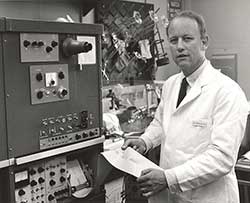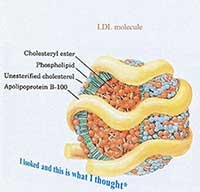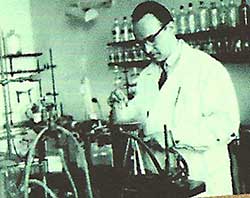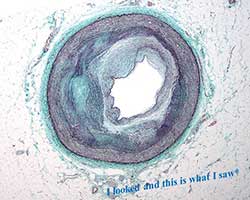
Visual Representations and Perceptions
of Lipoproteins and Atherosclerosis
- Elisa Campos
_______________________________

Fig. 6. D. Fredrikson at National Institutes
of Health, 1969 

Fig. 9. Lipoproteins structure 


National Institutes of Health and Donald Fredrikson
In figure 6 we have Donald Fredrikson (1924-2002) at the National Institutes of Health (NIH), Bethesda, Maryland, next to another iconic apparatus, the aminoacid analyser, in 1969, when researchers started becoming curious about the protein faction of lipoproteins. The National Heart Institute was created in 1948, promoting the recruitment of young scientists as directors of research laboratories, as well as young physicians who had completed their specialty in internal medicine, which was necessary given the opening in 1953 of the new clinical center – the first hospital on the NIH campus. Among the young doctors who joined the NIH in 1953 was Donald Fredrickson.
Images that suggest a proposition tend to be more fruitful for later researchers. That is what we can observe in the next illustration, drawn by Fredrickson (fig. 7  ). In 1958 there was not a scale for the lipoprotein particles, so in 2008 there was a dynamic hybridization with the introduction of the diameter on the x axis; this sparked a reinterpretation, giving new meaning to the image. And this picture has a second function, a significant pedagogical content.
). In 1958 there was not a scale for the lipoprotein particles, so in 2008 there was a dynamic hybridization with the introduction of the diameter on the x axis; this sparked a reinterpretation, giving new meaning to the image. And this picture has a second function, a significant pedagogical content.
The act of classification is an attempt to discover some semblance of order in Nature. Knowledge must be codified and stored so that succeeding observations may be compared and differences, however subtle, can be investigated and clarified (fig. 8  ). By bringing order and clarity to an illustration, specifics may suggest generalizations. Scientists must revise their explanations when they uncover a previously hidden aspect of a phenomenon. That is how this classification was later modified.
). By bringing order and clarity to an illustration, specifics may suggest generalizations. Scientists must revise their explanations when they uncover a previously hidden aspect of a phenomenon. That is how this classification was later modified.
Cholesterol, being insoluble in aqueous solution, is transported in plasma in association with specialized proteins – apolipoproteins (fig. 9). We have descriptive names for biochemical compounds; this figure enhances “nonverbal reasoning ability.” Indeed, the structure of a lipoprotein is not easily reduced to words.
Apolipoproteins and the Lipoprotein Concept of Petar Alaupovic
There are laboratories that force a change in itinerary which others follow, recruiting more participants from faraway places. Petar Alaupovic’s laboratory was one such example (fig. 10). In the publication of the David Rubinstein Memorial Lecture [4], Alaupovic (1923-2014), when transcribing the words of the poem “The Road Not Taken,” by Robert Frost, expressed his own journey:
I shall be telling this with a sigh
Somewhere ages and ages hence:
Two roads diverged in a wood, and I—
I took the one less traveled by,
And that has made all the difference.
The study of lipoprotein families and determination of apolipoproteins are inextricably linked to Alaupovic (fig. 11  ). Scientists have always found ways of making people believe that phenomena illustrate themselves. Alaupovic introduced a new technique to isolate lipoproteins according to their composition of apolipoproteins, based on immunoaffinity cromatography. Such thought experiments may be generated by dissatisfaction with previously expressed explanations; by new or faintly glimpsed observations; or by a heightened state of awareness of subtle, intangible discontinuities. In the sciences, the memory of observed phenomena, illustrations, and quantitative relationships are subject to mental scanning and meditation that may produce new insights. It seems we cannot think about an observation or experience in the objective world without resorting to mental imagery.
). Scientists have always found ways of making people believe that phenomena illustrate themselves. Alaupovic introduced a new technique to isolate lipoproteins according to their composition of apolipoproteins, based on immunoaffinity cromatography. Such thought experiments may be generated by dissatisfaction with previously expressed explanations; by new or faintly glimpsed observations; or by a heightened state of awareness of subtle, intangible discontinuities. In the sciences, the memory of observed phenomena, illustrations, and quantitative relationships are subject to mental scanning and meditation that may produce new insights. It seems we cannot think about an observation or experience in the objective world without resorting to mental imagery.
The Atherosclerotic Process
The observation of a repeated pattern provokes the scientist to seek the cause of the phenomenon, and that is how scientists were able to understand the atherosclerotic process. A histological section is also among the conventionally accepted resources that can be interposed between the phenomenon and the investigator to capture the event for analytical study, another way of “making phenomena illustrate themselves,” (fig. 12). The fundamental lesion of atherosclerosis is the fibro-fatty plaque. Atherosclerosis develops over several years and may be asymptomatic. It tends to affect the inner walls of large and medium-sized arteries, resulting in narrowing of the vessel. Symptomatic atherosclerosis may occur in minutes and the clinical consequences can include coronary artery disease, cerebrovascular disease or peripheral vascular disease (claudication, gangrene). The atherosclerotic lesion is essentially an injury of the arterial wall caused by the lipids in the blood stream invading it. The most relevant fact that supports the association between elevated levels of cholesterol and the process of atherogenesis and of coronary heart disease was described in 1938 in relation to homozygous familial hypercholesterolemia (FH), a hereditary condition characterized by extremely high cholesterol [5].
[4] Alaupovic P., David Rubinstein Memorial Lecture: “The Biochemical and Clinical Significance of the Interrelationship between Very Low Density and High Density Lipoproteins,” Canadian Journal of Biochemistry, 59, 1981, pp. 565-579.
[5] Müller, C., “Xanthomata, Hypercholesterolemia, Angina Pectoris,” Acta Medica Scandinavica, 89, suppl., 1938, pp. 75-84.


